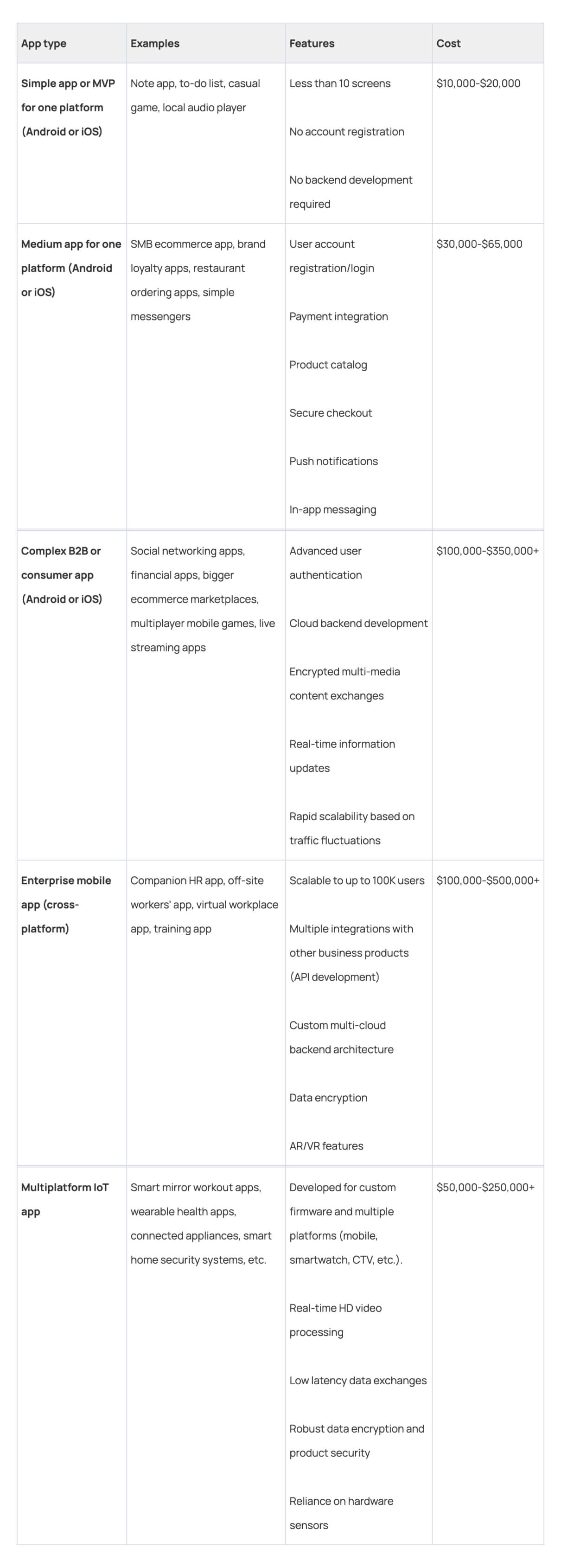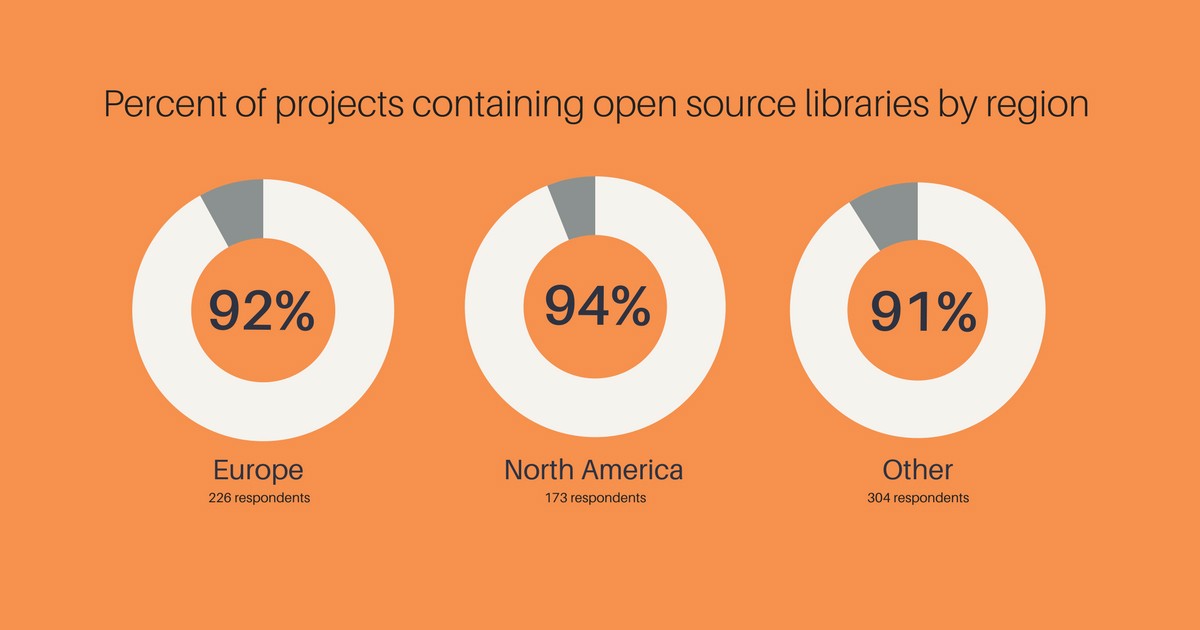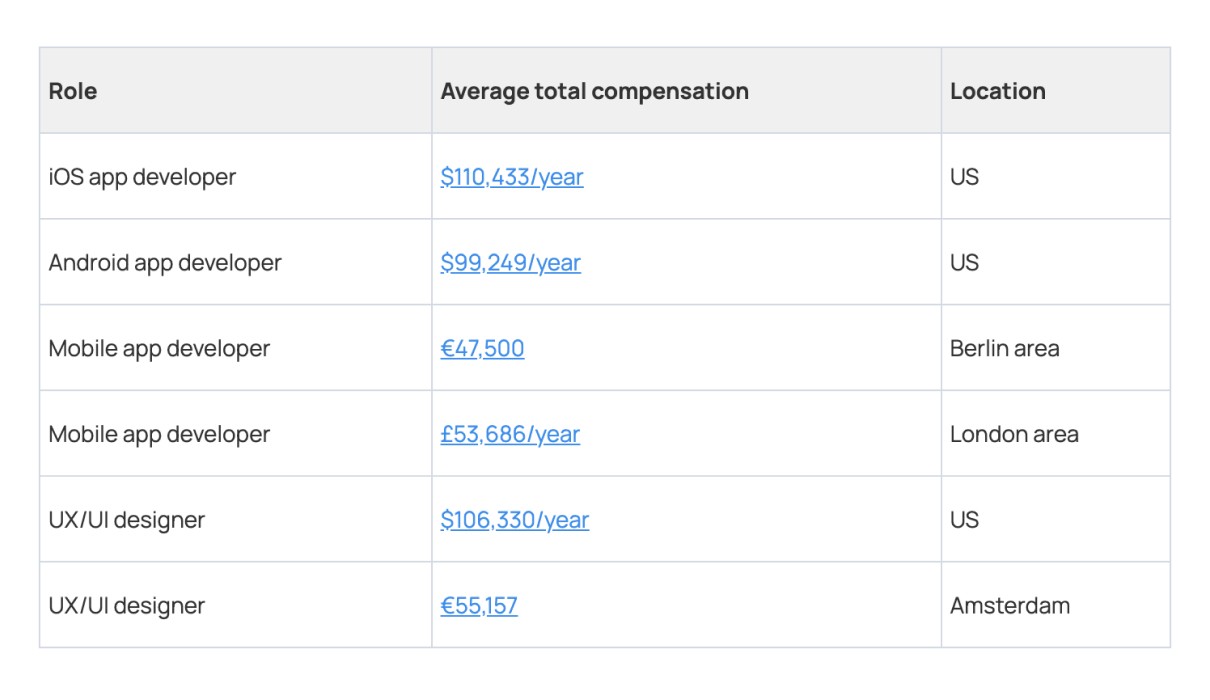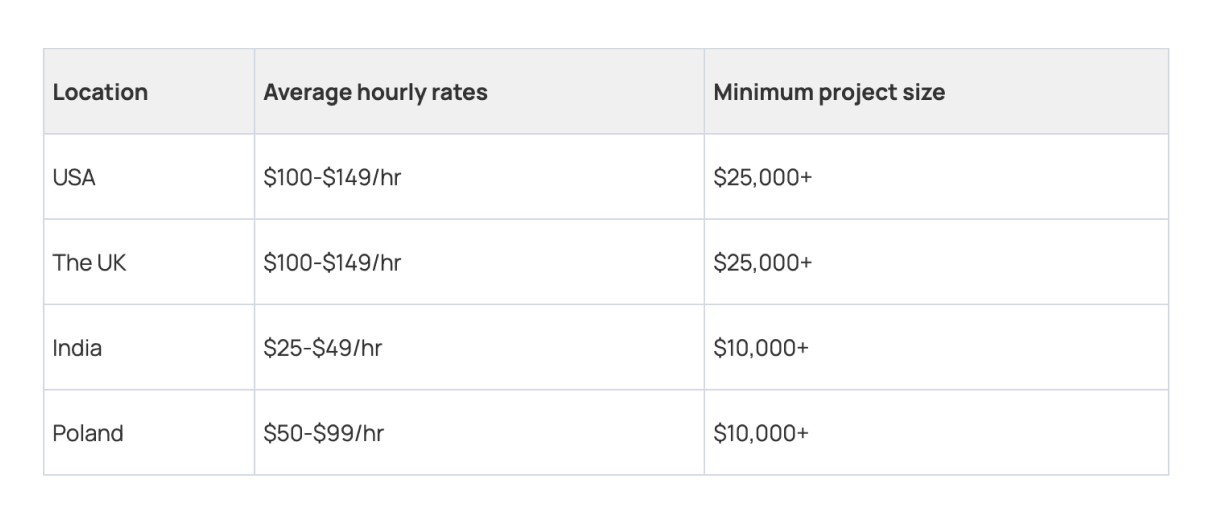App development cost in 2023 (factors, estimates & examples)
January 31, 2023
What’s the average app development cost?
This question gets over 2.9 million search results on Google.
Meaning a) it’s a popular one and b) it’s a challenging one to answer.
Mobile app development cost estimation is challenging due to many variables, such as app functionality, selected technologies, team composition, and project timelines.
That’s why the app cost estimation process exists.
This post breaks down all factors affecting app development costs and provides some ballpark estimates.
How Much Does It Cost to Build an App?
You want an instant answer, right?
So here are some numbers to satisfy your curiosity.
We then explain what exactly goes into the total app development cost estimate.

Examples of App Cost Estimate
What goes into the above app cost range?
These detailed app development cost breakdowns by app type will offer you extra context.
Social Network App Development Cost
Clubhouse, Geneva app, Polywork, BeReal — new social media apps emerge every other month.
That’s hardly surprising because the creator economy is now worth $104 billion. And investors are looking to cash in too. In 2022, startups focused on content creators got over $637 million in VC funding.
If you want to launch the next TikTok or Instagram, here’s a sample app development cost breakdown for a social media app.
Total mobile app development cost for a social media app: $68,000-$93,000.
UX/UI design + user research: $15,000-$35,000.
Development costs by features:
Account registration and setup: $1,000+
Encrypted group messaging: $5,000+
Multimedia content sharing: $4,500+
Audio calls: $3,500+
Video calls: $6,000+
Photo editing features: $18,000+
Local cache architecture: $4,500+
AR masks and filters: $5,500+
App quality assurance (QA): $5,000-$10,000.
Annual app maintenance costs: $10,000-$13,000 (15-20% of the total development cost). These will increase progressively as your user base grows.
Ecommerce App Development Cost
Mobile commerce is booming.
In 2022, shoppers checked out some $3.56 trillion worth of goods via their smartphones.
That’s 22.3% higher than a year before. With shopping app features coming to social networks, this niche will only get bigger in this decade.
The cost of ecommerce mobile apps differs greatly depending on your store size and user journey complexities.
For example, if you’re a small cosmetics retailer selling fewer SKUs, the app development cost will be lower.
But if you have a jumbo-sized product catalog requiring robust search functionality or want to offer app-based product customizations, plan a bigger app development budget.
Total mobile app development cost in ecommerce: $65,500-$85,500.
UX/UI design + user research: $8,000-$25,000.
Development costs by features:
Login and account registration creation: $1,500+
Push notifications: $1,000+
Payment integration: $2,500+
Customized checkout process: $10,000+
Advanced product search: $3,000+
Wishlist: $1,500+
Product catalog: $8,000+
Integrations with ecommerce platform + others apps: $8,000+
Personalized product recommendations: $12,000+
Customer support area with chatbot: $5,000+
App quality assurance (QA): $5,000-$8,000.
Annual app maintenance costs: $9,800-$17,000 (15-20% of the total development cost).
Mobile Banking App Development Cost
Mobile-only banks are eroding the profits of traditional players. Revolut, Chime, N26, and C6 Bank, among others, already tout a unicorn status ($1+ billion in valuation).
Incumbent banks are now catching up with them as the demand for mobile banking grows. In the US, 80% of consumers name “mobile” as their preferred channel for financial services.
When it comes to banking app development, there's good and bad news.
👍 The bad news is that you’ll be subject to stringent compliance and security regulations. It will increase your app development cost.
👎 The good news is that you can circumnavigate compliance requirements by selecting pre-made APIs and banking as a service (BaaS) products for your mobile app.
In fact, that’s the route challenger banks choose. N26, for example, embeds tech products from multiple partners (such as Raisin, Allianz, simplesurance, Wise, auxmoney, Younited Credit, and more) instead of developing core financial technologies in-house.
Instead, they focus on delivering a superior user experience (UX) to their target audience. That’s a smart strategy you can borrow for your app development process.
The total app development cost of a mobile banking app: $168,000-$213,000.
UX/UI design + user research: $15,000-$45,000.
Development costs by features:
Digital account opening: $15,000+
Integration with KYC partner: $5,000+
Integration with a BaaS platform: $25,000+
Account top up: $5,000+
Apple Pay/Google Pay integration: $8,000+
Money transfer (local + FX): $15,000+
Personal finance tools: $10,000+
Savings pots: $15,000+
Trading features: $35,000+
App quality assurance (QA): $20,000-$35,000+.
Annual app maintenance costs: $25,000-$33,000 (15-20% of the total development cost).
What Goes Into Mobile App Development Cost?
Mobile app development cost depends on two major factors — the number of planned app features (overall app complexity) and app developers' compensation.
The above will make up the bulk of your total app budget. That said: other tech and operational decisions also influence development costs.
This section includes all the direct and hidden app development costs you should consider.
Core App Functionality
A complex app is more expensive to develop.
By “complex,” we mean cross-platform products with 10+ features, multiple user flows, and multi-step business logic.
To put the above into context:
Basic app: offline radio app with no account registration for one operating system (Android).
Complex app: online travel booking iOS app for smartphones and tablets with real-time route building, price comparison, and checkout.
Most commercial consumer apps fall into the complex category. Within this category, mobile app costs can differ depending on the total number of features, technologies used, or security/compliance requirements.
Technologies driving the total mobile app development cost:
Usage of smartphone hardware features such as GPS, Bluetooth, biometrics, NFC, or other sensors.
Integrations with other hardware such as IoT devices, wearables, connected equipment, etc.
Extra security requirements, e.g., for financial products such as PSD2 or PCI compliance.
Artificial intelligence (AI) features to power data analytics, image recognition, or app search features.
AR/VR app features since this requires extra app development expertise and time for testing.
It’s a good idea to first build an app with 5-8 core features (an MVP version). Then include extra functionality once your product gets traction with target users or you secure extra funding.
Take it from Tom Blomfield, CEO of Monzo. He admits to launching Monzo “very, very, early…like scary early.”
But this decision allowed Monzo to test their product with live users and validate earlier app ideas before sinking more money into app development.
Tech Stack
Your app architecture, number of supported OS versions and device types, and specific tech choices, will be detrimental to the product's final cost.
In our experience as an app development company, these two factors impact app costs:
Number of supported platforms
Open-source vs. proprietary tech usage
Supported app platforms
Choosing between a native app, a hybrid app, or a cross-platform app should be your first step.
A native app is purpose-built for a particular platform — Android or iOS.
A hybrid app is a mobile-friendly “shell” added to an existing web application. Essentially, you’re converting your web app into two native apps using code elements for the mobile platforms.
A cross-platform app has a shared code base for several operating systems, re-used to create platform-specific apps.
Native mobile app development for two platforms costs more (obviously). Cross-platform app development is faster and cheaper, but there are tradeoffs in app performance, usability, and customization.
Hybrid apps also cost less to develop and have lower maintenance costs. But you’re even more limited with app functionality and can't build offline products. That’s why most entrepreneurs view hybrid app development as a viable MVP route but not a great choice for mobile-first products.
Native app development takes the most time and commands the highest budget. But it’s the only way to gain access to full smartphone functionality (camera, geolocation, etc.) and launch complex but convenient UI elements such as image processing, splash screens, real-time navigation, etc.
In 2018, Airbnb made a tough decision to sunset React Native (a popular cross-platform app development framework) and built native Android and iOS apps instead.
In addition, large amounts of bridging infrastructure were required to enable product engineers to work effectively. As a result, we wound up supporting code on three platforms instead of two. We saw the potential for code sharing between mobile and web and were able to share a few npm packages but beyond that, it never materialized in a meaningful way. – Gabriel Peal, former Senior Software Engineer at Airbnb
The takeaway: if you want to build a future-proof app, go native from day one. To save some cash, begin with one platform.
iOS apps typically have higher design costs (because of Apple’s detailed UX requirements) but lower app development costs (thanks to better standardization).
Android apps cost less to design (thanks to available free design patterns and references) but are more complex to develop. Android devices are less standardized regarding screen size, hardware features, and OS versions installed. This pushes development costs higher and makes app maintenance more expensive.
Best advice? Choose a platform your target audience prefers.
Open source vs. proprietary technology
Open-source mobile app development frameworks, tools, and libraries are 100% free to use and customize.
Instead of “re-inventing the wheel,” an app developer can use pre-made mobile SDKs to create popular app features, build backend databases, or integrate your mobile app with other software.
Open-source usage speeds up the app development timeline, so many teams use such components.

Open-source code usage globally: Source: Tidelift.
That said: using proprietary (closed-sourced, paid) technologies isn’t that bad either. In this case, you get:
Access to more features, available out-of-the-box
Better documentation and customer support
Higher solution security and regular updates
Using proprietary technologies (such as a BaaS platform) can dramatically increase time-to-market for your product, plus reduce app testing costs.
In some cases, using premium mobile SDKs, APIs, or other “as a service” offerings is more cost-effective than building the same functionality from scratch.
IT Infrastructure
Every app cost includes human labor costs (design, coding, testing) and infrastructure setup and maintenance costs.
Required mobile app infrastructure includes
App servers (local or virtual)
Data storage
Networking
API connectivity
Security services
This spending can easily add up, especially after the app release. On average, startups (not just mobile) burn $117,400 monthly on misc tech and operational expenses.
The number rises to $469,300 at the Series A stage.
You can reduce maintenance costs by making smarter tech choices regarding cloud computing and API usage at the development stage.
Cloud Computing Costs
Hosting, virtual development environments, servers, databases – a short list of cloud app infrastructure you’ll need.
Big cloud players like AWS, Microsoft Azure, and GCP let you get computing resources for cheap. But your total cloud bill can spiral out of control without proper cost optimization and smart app architecture choices.
The Adobe development team learned this lesson the hard way. An error in misconfigurations left them with an $80,000 daily cloud bill. Ouch!
To keep your cloud costs at bay:
Set custom controls for different cloud workload requirements to ensure automatic scaling (up/down) based on app performance stats.
Select the right scalability model. For example, with virtualization, you can run multiple OS on one physical server, but with containerization, you can run multiple mobile apps on the same OS and one VM or physical server.
Always right-size your instances to the allocated workload. It’s easy to reserve bigger instances for later and then not use them at full capacity.
Manage data redundancies. Data backups are important, but you don’t need to duplicate all your data across multiple sites.
Our mobile app development company is always happy to provide extra cloud optimization tips.
APIs and Integrations
Application programming interface (API) is a pre-made “connector,” enabling communication between different software systems.
APIs provide access to data stored in other apps and let you embed app functionality from third parties.
For example, you can use Stripe API to process in-app payments instead of developing your payment processing features. Or you can use an OpenWeatherMap API to show real-time weather conditions in a user’s location.
Some APIs are free to use. Others come with a subscription plan or per-call cost. The average API cost per call is just $.01266, but when you make that call 100K times per week, that’s an extra $1,000+ for just one API.
Apart from paying for API usage, you’ll need to securely integrate it into your product. That’s several more hours of work from a mobile app developer.
Separately, you may want to integrate your mobile app with other proprietary products (e.g., a CRM or a POS system).
Add another line to your app budget, if there’s no pre-made API for connectivity, add another line to your app budget.
➡️ API development costs fall in the $5,000-$20,000 range.
App Design
Mobile app design is another cost-driving factor.
The total app design costs usually include:
User research
Wireframing
Prototyping
Final UX/UI design
Extra UX audit (optional)
Design work begins before development but influences its speed and cost. Wireframes and prototypes help you visualize the main user flows, navigation between screens, and overall app logic.
That prevents poor design choices from being transferred into an actual product. Companies spend around 20% of their development time on UX/UI design.
App design costs rise proportionally to the number of planned app screens and the business logic behind app features.
Designing basic features such as account registration, shopping cart, or in-app messaging takes less time than drawing multi-dimension gaming worlds.
Factors increasing mobile app design costs include:
3D visualizations and motion design elements. A 3D gaming app will cost more to design than a simple health tracker.
Compex user onboarding process. For example, for an enterprise app where you need to collect user credentials, payment information, ID documents, etc.
AR/VR experiences require niche design expertise and extra testing time.
Brand new product experiences. For example, if you’re building a mobile app for a new medium (e.g., an in-dashboard shopping app for a connected car) or a new use case (e.g., to show in a cashier-less store), your design process will be longer.
➡️ Mobile app design costs depend on your app's complexity. The average budget is $5,000-$15,000 for a simple app design and $25,000+ for visualizing a complex app idea.
Mobile App Development Team
Unless you plan to code a simple app yourself, you’ll need expert help.
You can assemble an in-house team, hire a freelance app developer (or an entire app development team), or approach a custom software development company.
In each case, you’ll end up with a somewhat different cost. Let’s see how they compare.
Team Size and Composition
You can’t estimate the total mobile app cost without figuring out the optimal app development team composition.
You need more than just good mobile app developers to develop an app. You should also have:
Product owner
Project manager or Team leader
Business analyst(s)
UX/UI designer(s)
iOS/Android app developer(s)
Backend app developer(s)
Quality assurance specialist(s)
Some of these roles may be present at your end, for example, Product Owner and Project Manager + Business Analyst.
But you’ll need to fill in the other ones either by hiring internally or through outsourcing app development.
In-House vs. Outsourcing Mobile App Development Cost
Outstanding IT talent is hard to find. Some 47% of businesses already deal with tech talent shortages.
Mobile app developers are in short supply as the demand for their expertise keeps rising. Today, even the likes of Google, Microsoft, and Zillow struggle to retain their best talent.
High demand reflects on mobile app developers' salaries, progressively climbing up in popular tech hubs.

The above app developers salaries are median, offered across companies and experience levels.
For example, the median compensation for a Product Designer in New York City is $161,000. It’s 47% higher than the national average compensation of $76,105.
Apart from base compensation, if you factor in extra employee overhead costs (1.2-1.4 times the annual salary), you’ll get the actual price of hiring in-house mobile app developers.
Since not all companies can afford app developers on payroll (or need a permanent team), the second popular option is working with a mobile app development company (like us!).
The perks of working with a mobile app development agency:
Hot-key access to app development talent
Cross-functional, experienced teams
Diverse industry experiences
Flexible, fast project start
Ability to build long-term partnerships
Another big advantage? You can start with a smaller team to get an MVP done. Then retain extra people for full-scale product development — and scale back after a major release.
Mobile app development companies charge either per hour or per project. In both cases, you receive a detailed app development cost estimate before signing the partnership deal, based on your list of requirements.
Agency costs differ a lot based on their specialty, experience levels, location, and industry reputation (+ your app specs).
Sample mobile app development company costs

Data from Clutch.
How to Estimate Mobile App Development Costs
Understanding the approximate app development timeline is key to determining the total cost of your app.
An hour remains the easiest measure for estimating the volume of work done. Thus, both in-house app developers, freelancers, and agencies try to determine how many hours will go into the proposed mobile app development project and adjust the budgets accordingly.
That said: you should always add extra padding.
Per the 2021 PMI survey, only 61% of software development projects are completed within the original budget.
To approximate the total development cost for your app, complete the next steps.
Perform Business Analysis
Business analysis is a structured process for identifying business needs and creating appropriate software solutions.
In app development, a business analyst (BA) helps conceptualize your app idea and prepare an app requirements document. It includes:
Main product goals
List of features
Competitive advantage
Business requirements
Technical app requirements
Separately, a BA helps prepare a preliminary Scope of Work (SoW) document, which app developers can refer to for making project estimates.
Prepare Reference Mobile App Architecture
Selected technologies will impact the app's complexity, hence development speed and cost. Before beginning app development, you must prepare a reference mobile app architecture that includes:
Presentation layer. All UX/UI elements and technical specs for implementing them.
Business layer. Tech and operational requirements for app security, data validation, logging, and cache management.
Data layer. API strategy, data integrations, plus data management and governance practices.
Backend architecture. Underlying system architecture patterns.
All the above information should be separately reflected in your final list of app requirements and scope of work (SoW) document.
Afterward, you’ll use these details to create a product development backlog and sprint plans.
Calculate App Development Timeline
Break down the entire mobile app development process into key stages – project setup/planning, app design, app development sprints (frontend/backend), and app testing. Then make time-based estimates for each stage.
You can use different methods of estimation planning such as:
Concepts
User Stories
Story Points
➡️ Learn more about app development project timeline planning.
In the end, you arrive at a preliminary Sprint plan plus general time estimates for each project stage (or parts of it). With the above data, you can make accurate app development cost projections.
If you’re working with a mobile app development company, you’ll be offered either of these pricing models.
Fixed price. You receive a project price quote based on the pre-approved scope of work and a list of app requirements. The quote covers end-to-end services delivery — from design to app release.
Project-based pricing works best for simple app development, MVPs, and proof of concept (POC) solutions.
Times and material (hourly contracts). This app pricing model is more common for long-term, large-scale app development projects.
In this case, you get billed for the total number of hours the agency spends on developing an app.
Usually, the quoted hourly rates include the agency profit margin and some extra buffer to account for last-moment changes or scope creep. That’s why agency hourly app development rates are higher than in-house people's.
➡️ To get the most accurate app development price, always approach app developers with a clear list of requirements.
Final Thoughts
Developing apps ain’t cheap, but it’s well worth it!
Last year, Android and iOS apps crossed the $133 billion revenue mark through advertising, paid subscription tiers, and in-app sales.
The above is just the tip of the iceberg, however. As many mobile apps make way more money through direct sales, transactional revenue, or service delivery.
For example, MyFitnessPal generated over $8,9 million in 2022, whereas dating app Bumble plans to make $240 million in revenue in 2022.
The best part? The booming app economy still has plenty of untapped niches and revenue streams your product can capture!
FAQs about Mobile App Development Cost
Got some more questions about app development costs left? We’ve got answers!
How much do app developers charge per hour?
App developer rates differ by experience, location, and type of contract (short-term or long-term).
According to Arc.dev, senior freelance iOS app developers in North America charge $121-140 on average, but their Eastern European peers have a going rate of $81-100.
In Latin America, you can hire a junior iOS app developer for $41-60/hour, but in Western Europe, junior iOS developers charge $81-100 per hour.
You can negotiate more competitive rates by offering long-term engagement (6+ months) rather than short-term consults.
Why do apps cost so much to make?
The cost to develop an app is so high because good engineering and design talent are expensive.
You can code together an app yourself using freemium builders, but it won’t look anywhere close to a professionally made product.
You pay for years of education, practical work, and business acumen.
How many developers are needed to make an app?
The optimal development team size depends on your product complexity.
To create a simple fitness tracking Android app, you may need just 2-3 app developers + 1 UX designer. But to make and support a complex app like Instagram, you may need a team of 50+ engineers.
Most entrepreneurs start with an MVP version, built by a small team (under 5 people). Then hire extra talent to scale up product development.
How much does it cost to run an app per month?
On average, monthly app maintenance makes up 15%-20% of the total app development budget. But costs can differ depending on your product type and traffic volumes.
For example, maintaining a popular weather app will cost less because you’ll have a simple app infrastructure (no databases or special security controls required).
But maintenance costs for a digital bank will be higher since your app has more features (read needs more computing resources), relies on third-party APIs, requires redundant data storage, and has more networking requirements.
What percentage of apps succeed?
Let’s define success as “minimum 1,000 app downloads” from app stores. Based on this metric, 68% of Android apps never become successful.
Caveat: Google Play has over 2.65 million published apps, so the competition is tough.
Many consumer apps aren’t successful because of poor design, zero promotion activities, or limited functionality.
